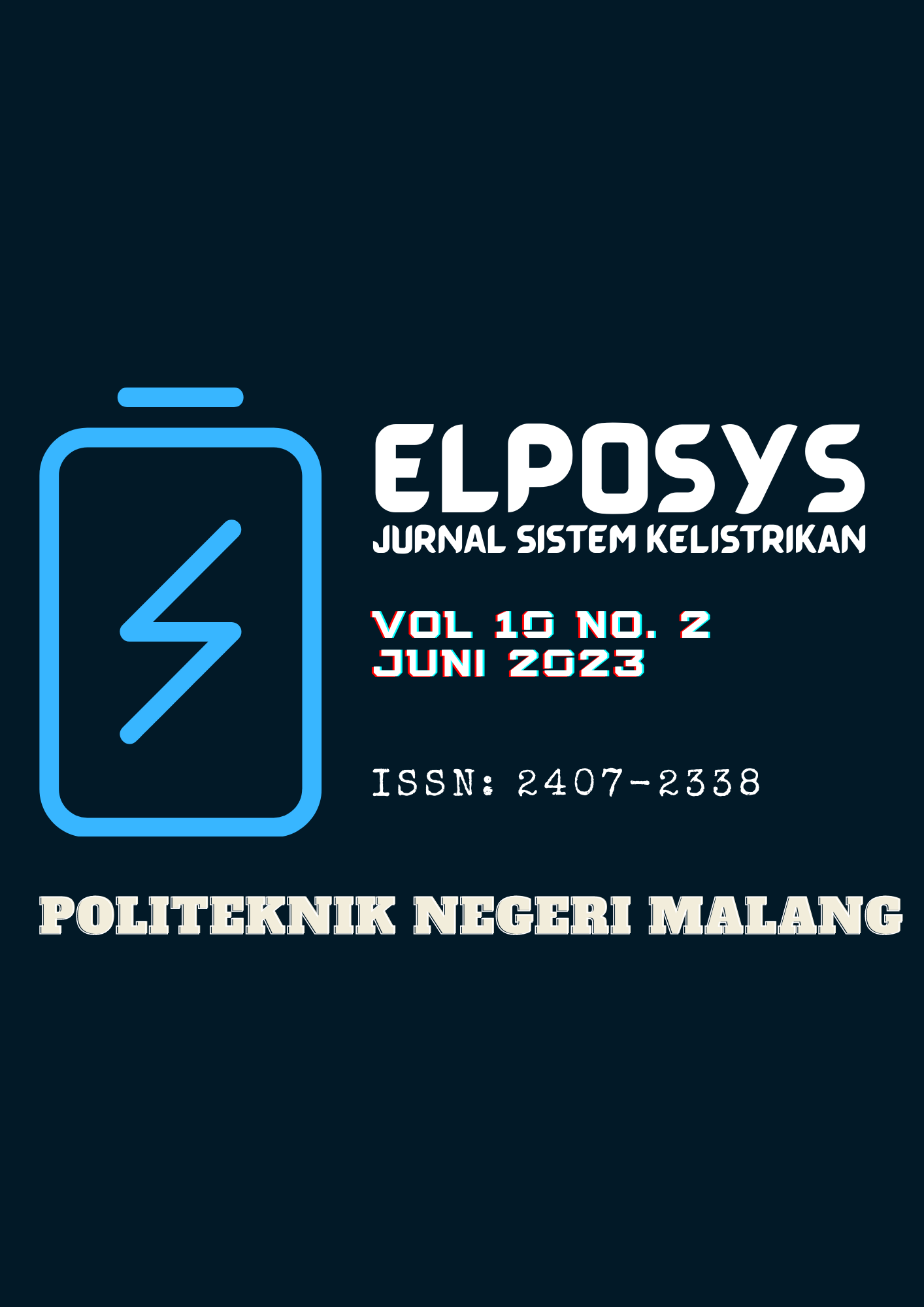Analisis Pengaruh Suhu Dan Partial Shading Terhadap Output Daya PV 100-WP Untuk Sistem Hidroponik
DOI:
https://doi.org/10.33795/elposys.v10i2.3066Keywords:
Hydroponics, Temperature, Partial Shading, Output Power, Solar Power PlantAbstract
This experiment discusses the effect of the variability of solar radiation due to partial shading and surface temperature of the PV Panel on the output power of 100 Wp solar panels. This study begins by determining the load of the system, i.e. DC pump in the nutrient circulation system of the DFT hydroponic system. From there, we can observe the change in solar panel power output and PV surface temperature change due to partial shade. This survey method actually measures the temperature and intensity of solar radiation and measures the power output of a solar panel, and the tools used are thermal sensors used to measure the surface temperature of solar panels. Solar power meter. to measure the solar irradiance and use the multimeter to measure the voltage and current, 10A capacity SCC battery, 100Wp capacity solar panel and 65Ah battery. The test will be conducted for 5 days, starting from 09:00 to 15:00 every day. This result shows that temperature increase affects the output power decrease when the solar panel is in normal condition (not half shaded condition). On the other hand, when partial shade conditions increase, the temperature does not affect the decrease in solar panel output power. The greater the intensity of partial shade produced by the solar panel, the lower the output power. However, for short periods of partial shade, the output power produced tends to be more stable than under normal conditions.
References
Lukitobudi, A. R., Prasetyo, B. Y., Harish, M. F. N., & Fadhil, D. A. (2021). PERANCANGAN SISTEM BRINE COOLING PADA SHOWCASE DAN KABIN HIDROPONIK UNTUK TANAMAN KANGKUNG ( IPOMOEA AQUATICA ). 6(2), 211–218.
Fitriyatus, A., Fauzi, A., & Juanda, B. (2018). Peramalan Penyediaan dan Konsumsi Bahan Bakar Minyak Indonesia dengan Model Sistem Dinamik Prediction of Fuel Supply and Consumption in Indonesia with System Dynamics Model Pendahuluan. 17(2), 118–137.
Yuliananda, S., Sarya, G., & Hastijanti, R. R. (2015). Pengaruh Perubahan Intensitas Matahari Terhadap Daya Keluaran Panel Surya. Jurnal Pengabdian LPPM Untag Surabaya Nopember, 01(02), 193–202.
Ariani, W. D., & Winardi, B. (2014). Analisis Kapasitas Dan Biaya Pembangkit Listrik Tenaga Surya ( PLTS ) Komunal Desa Kaliwungu Kabupaten Banjarnegara. Transient, 3 No.2(Juni 2014), 158.
Aprillia, B. S., Rafiqy, M., & Rizal, A. (2019). Investigasi Efek Partial Shading Terhadap Daya Keluaran Sel Surya. Politeknik Caltex Riau, 5(2), 9–17.
Setiawan, D., Eteruddin, H., & Siswati, L. (2020). Sistem Pembangkit Listrik Tenaga Surya untuk Tanaman Hidroponik. Jurnal Teknik, 14(2), 208–215. https://doi.org/10.31849/teknik.v14i2.5377
Ramadhan, S. (2021). Perencanaan Pembangkit Listrik Tenaga Surya Berkapasitas 1,8 kWp sebagai Sumber energi Green House.
Asrori, A., & Yudiyanto, E. (2019). Kajian Karakteristik Temperatur Permukaan Panel terhadap Performansi Instalasi Panel Surya Tipe Mono dan Polikristal. FLYWHEEL : Jurnal Teknik Mesin Untirta, 1(1), 68. https://doi.org/10.36055/fwl.v1i1.7134
Pido, R., Himran, S., & Mahmuddin. (2018). Analisa Pengaruh Pendinginan Sel Surya Terhadap Daya Keluaran dan Efisiensi. Teknologi, 19(1), 31–38.
Nasir, J. A. (n.d.). Optimasi Perancangan Sel Suryauntuk Pembangkit Listrik 3500 W. 2(2), 115–119.
Hakim, M. F. (2017). Perancangan Rooftop Off Grid Solar Panel Pada Rumah Tinggal Sebagai Alternatif Sumber Energi Listrik. Dinamika Dotcom: Jurnal Pengembangan Manajemen Informatika dan Komputer.
R. . Duanaputri, I. Heryanto/Eryk, M. F. . Sajidan, M. F. Hakim, and Ayusta Lukita Wardani, “Sistem Monitoring Online Dan Analisis Perfomansi Plts Panel Surya Monocrystalline 100 Wp Berbasis Web ”, elposys, vol. 10, no. 1, pp. 1–6, Mar. 2023.
A. H. Santoso, M. . Saputra, and F. N. R. Hamka, “PLTS sebagai Backup Supply pada Plant Hidroponik Nutrient Film Tehcnique (NFT) Berbasis IoT”, elposys, vol. 10, no. 1, pp. 19–23, Mar. 2023.
A. Ziemińska-Stolarska, M. Pietrzak, and I. Zbiciński, “Application of LCA to Determine Environmental Impact of Concentrated Photovoltaic Solar Panels—State-of-the-Art,” Energies, vol. 14, no. 11, p. 3143, May 2021.
Myyas, R. E. N., Al-Dabbasa, M., Tostado-Véliz, M., & Jurado, F. (2022). A novel solar panel cleaning mechanism to improve performance and harvesting rainwater. Solar Energy, 237, 19-28.
Downloads
Published
How to Cite
Issue
Section
License
Copyright (c) 2023 Elposys: Jurnal Sistem Kelistrikan

This work is licensed under a Creative Commons Attribution-NonCommercial 4.0 International License.








